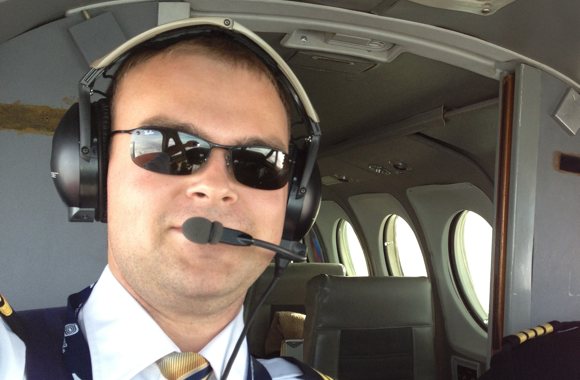
Are These Aviation Myths Preventing YOU From Learning to Fly

The aviation industry remains a bit of a hard sell.
Ottawa Aviation Services’ Cedric Paillard dispels some common myths about becoming a pilot.
It’s an industry that’s experiencing a high Baby Boomer retirement rate, offers an enviable employment rate for new graduates, will require an estimated 97,000 new hires over the next two decades in North America alone and urgently needs new recruits.
So why is the aviation industry having so much trouble finding new recruits?
For Cedric Paillard, CEO of Ottawa Aviation Services, the myths about what it takes to become a pilot may be part of the reason why young men and women aren’t considering the field.
Opened 20 years ago, Ottawa Aviation Services (OAS) offers its students a professional approach to flight training using the most modern in flight simulations combined with comprehensive instruction from a team of aviation professionals. Through its partnerships with various airlines, Ottawa Aviation Services also provides placement services that guarantee job interviews for qualified students.
And yet, says Paillard, the aviation industry remains a bit of a hard sell. So what myths might keep newcomers from entering the field of aviation?
Myth #5: You Have To Be A Genius To Become A Pilot.
“Most people think they have to be geniuses in math or physics to become a pilot,” says Paillard. However, this isn’t necessarily the case.
Before attending OAS, all prospective students must partake in aptitude and skill assessment testing at the school’s Pilot Assessment Centre. Part of the testing is done to identify areas where prospective students may need some help to satisfy OAS’ requirements.
The Pilot Assessment Centre allows OAS to create a program “tailored to the results of each student’s individual tests,” says Paillard. This includes aptitudes and skills enhancement training to upgrade skills to strengthen areas where the student showed weakness during testing.
So don’t let that so-so grade in algebra stop you: OAS will help get motivated, passionate prospects upgrade to the skill level they need to pursue their pilot’s license.
Myth #4: You Have to Have Contacts in the Industry to Even Get an Interview
Not necessarily true, says Paillard. In fact, successful graduates of the school’s Integrated Airline Transport Pilot Licence (ATPL) program are guaranteed a job interview if they meet the benchmarks of the program defined with the airline.
The Integrated ATPL program focuses on “stick and rudder” skills, upset recovery training, glass cockpit and multi-crew training. Upon completion, students obtain a “frozen” Airline Transport Pilot License with 250 hours of flight and 766 hours of ground school, which is valid for five years or until a total of 1500 hours are accumulated, whichever comes first.
In as little as 18 months, iATPL graduates students can go from training straight to a guaranteed job interview with an OAS airline partner.
Myth #3: It’s Too Expensive to Become a Pilot.
The fact is that, for every dollar invested in getting an aviation degree, you earn back $33.
“Low salary at the beginning of a career is an issue,” admits Paillard, “considering working hours per month and benefits it’s one of the best jobs.”
Despite the relatively low yearly salary of a beginner pilot, graduates can look forward to steady pay increases that make the repayment of loans easy to budget — and afford!
“We have put in place a financial assistance with RBC to help with the financial aspect of the training,” says Paillard. The program gives students access to a generous line of credit and is designed to reduce the worry potential students have about borrowing while also encouraging them to pursue their dream of hitting the wild blue yonder.
Myth #2: I’m Not Fit Enough to Become a Pilot
Contrary to popular misconceptions, you don’t have to be a professional athlete to become a pilot. However, due to the magnitude of the pilot’s responsibility for passenger safety and the potential stress and quick thinking required, prospective students must have a Class 1 Aviation Medical exam done as part of the OAS enrollment process.
The exam reviews general health condition including vision and hearing, and screens for any conditions that might suddenly incapacitate a pilot. Candidates who use corrective lenses may still qualify for commercial medical standards.
At OAS, the medical exam and Pilot Assessment test are both performed – the former to gauge physical fitness; the latter to gauge “psychological readiness and aptitude,” says Paillard.
“Flying is a skill and we want to make sure the individual is not going to spend a lot of money on training they will never be able to complete.”
For selected students, the next big test just may be the flight training done with the Mechtronix Systems Flight Simulator, where they face normal and abnormal flight conditions using scenario-based training.
“From weather avoidance and pilot decision-making to engine failure on take-off and passenger sickness requiring to divert to another airport, we try to reproduce a variety of scenarios that an airline pilot might encounter,” says Paillard. “We do all of this using the Standard Operating Procedures (SOPs) of our airlines partners, which reduces the students’ transition time [into employment] when they leave OAS.”
Those with a passion for flying should find out more about the standards that pilots must meet. With all the misconceptions out there – and with many factors judged on a case-by-case basis – it would be a shame to pass up on a career in aviation because of things you may have heard … that may not necessarily be true!
Myth #1: You Need a Crazy Kind of Passion for Flying to Become a Pilot
Well … yes!
The truth is, very few people consider a career in aviation unless they’ve had an interest in knowing what it feels like to pilot a plane and fly the skies.
“We do have students who want to become pilots strictly because it’s a good job,” says Paillard, but even for these students “the passion often comes … very soon after they start training.”
Paillard is unapologetic in his enthusiasm for all things related to his calling.
“Aviation is a passion,” he admits. “Training to become an airline pilot requires motivation and perseverance but it’s worth it!”
For more information on the pilot programs at Ottawa Aviation Services, contact the school and prepare to get your questions answered. And then, if you’ve got what it takes, prepare to take to the skies!
Schools mentioned: Ottawa Aviation Services


Leave a Reply